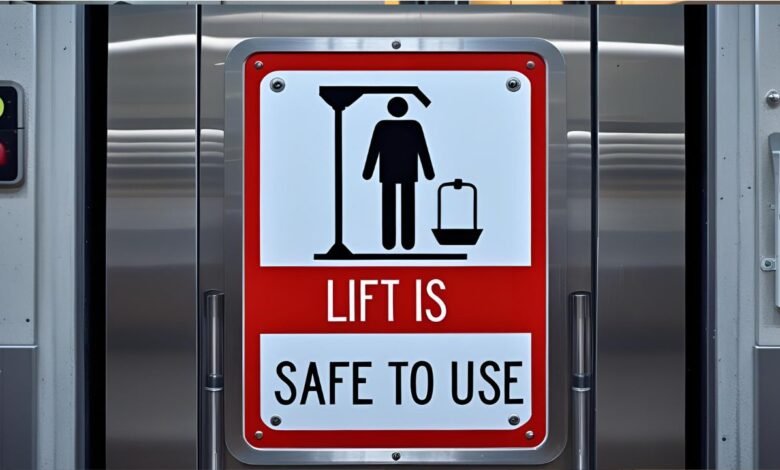This Sign Shows When a Lift is Safe to Use

Lift safety is a crucial aspect of our daily lives, yet it often goes unnoticed until an incident occurs. Every day, countless individuals rely on lifts to effortlessly navigate between floors in buildings. But how do you know when it’s safe to step inside? Understanding lift indicators and capacity signs can make all the difference in ensuring a secure ride. One sign stands out above the rest: the green light. This simple signal holds immense importance for anyone using a lift. Let’s explore what makes this sign essential for your safety and delve into other factors that contribute to a smooth lifting experience.
Understanding lift capacity and weight limits
Lift capacity refers to the maximum weight a lift can safely carry. Understanding this limit is crucial for ensuring user safety and preventing accidents.
Weight limits are determined by various factors, including the design of the lift and its mechanical components. Manufacturers provide specific ratings that should never be ignored.
Overloading a lift poses serious risks. It can lead to mechanical failure, which might result in injuries or even fatalities.
It’s essential to consider not just individual weights but also combined loads when multiple passengers are involved. Each person must be aware of their own weight as well as any additional items they may bring into the lift.
Regularly checking posted capacity signs inside and outside lifts helps maintain awareness. Always adhere strictly to these guidelines for your safety and others’.
Types of lift indicators and their purpose
Lift indicators play a crucial role in ensuring safety for users. They come in various forms, each designed to convey important information.
One common type is the weight indicator. This device shows whether the lift’s capacity has been exceeded. It helps prevent overloading, which can lead to mechanical failures or accidents.
Another essential indicator is the door status light. A green light usually signals that doors are secure and it’s safe to enter or exit. Conversely, a red light may indicate that doors are still closing or opening.
Some lifts also feature emergency alert systems. These indicators notify passengers of any issues requiring immediate attention from maintenance personnel.
Visual displays often show which floor the lift is currently on, enhancing user awareness and convenience during operation. Each of these indicators serves a specific purpose focused on improving safety and communication within the lift environment.
The
The importance of safety signals in lifts cannot be overstated. They serve as critical indicators for users, ensuring that everyone can navigate vertical spaces with confidence.
Among these signals, the green light is paramount. This simple yet effective indicator informs riders that the lift is safe to use.
When you see a green light on the control panel or above the door, it means everything checks out: weight limits are adhered to and there are no mechanical issues at play.
This clarity helps prevent accidents and promotes responsible usage of elevators in buildings.
It’s essential not just to rely solely on the signal but also stay aware of your surroundings when using a lift. A moment’s caution can make all the difference in maintaining a secure environment.
The green light sign: how it indicates a safe lift
The green light sign is a universal symbol that conveys safety and readiness. When you see this indicator illuminated on a lift, it means the elevator is operational and safe for use.
This bright green signal provides reassurance to passengers. It typically lights up once all safety checks are complete. The doors are secure, and the system has verified that weight limits have not been exceeded.
For those unfamiliar with lift operation, the green light serves as an essential reminder to always look for indicators before stepping inside. Ignoring other signs can lead to unsafe situations.
Understanding this simple yet vital cue fosters confidence in using lifts efficiently. Always be attentive to any changes in the signaling system while waiting for your ride.
Other important factors to consider before using a lift
Before stepping into a lift, it’s vital to check the surroundings. Look for any visible signs of wear or damage on the lift doors and control panel.
Always observe if there are any passengers inside. Avoid overcrowding; lifts have specific weight limits that should not be exceeded under any circumstances.
Listen for unusual noises when the lift is in operation. Sounds like grinding or excessive rattling can indicate mechanical issues that need immediate attention.
If you’re using a wheelchair or carrying heavy equipment, ensure there’s adequate space and accessibility within the lift.
Familiarize yourself with emergency procedures posted near the controls. Knowing what to do in case of an unexpected situation can make all the difference.
Ensure you’re wearing appropriate footwear to prevent slipping as you enter and exit the lift safely.
Proper training and maintenance for lift safety
Proper training for lift operators is essential. Understanding the mechanics and safety features of lifts can prevent accidents. Operators should be well-versed in emergency procedures, including how to handle malfunctions.
Regular maintenance checks are equally important. Lifts require routine inspections to ensure all components function correctly. This includes checking cables, brakes, and control systems.
Creating a maintenance schedule helps keep lifts in top condition. It also ensures compliance with safety regulations that vary by location.
Training sessions should occur periodically to refresh knowledge among staff. This keeps everyone informed about new protocols or updates in technology related to lift operations.
Encouraging open communication about lift issues fosters a culture of safety within buildings. Employees should feel empowered to report anything unusual without hesitation.
Conclusion: prioritize safety and follow all signs for a successful and safe use of lifts
Lift safety is paramount for anyone who uses them, whether in a commercial building or residential complex. Recognizing and understanding the signs that indicate when a lift is safe to use can prevent accidents and injuries.
Always pay attention to weight limits displayed inside the lift. This information ensures you do not exceed the maximum capacity, which could lead to malfunction or danger. Knowing how many people or items can safely fit into a lift helps maintain its functionality.
Types of indicators are essential tools designed to communicate important safety messages. From lights that signal operational status to warning alarms, these indicators serve as your first line of defense against potential hazards.
The green light signifies that it’s safe to enter the lift. When this light illuminates, it indicates that all systems are functioning correctly, providing assurance for users before stepping inside.
However, other factors also play crucial roles in ensuring your safety while using lifts. Always check for any unusual noises or malfunctions before entering. If something feels off, it’s best not to take any risks—wait for maintenance personnel if needed.
Proper training on how lifts operate should never be overlooked by staff members responsible for managing them. Regular maintenance checks are equally vital; they ensure all components work seamlessly together and comply with safety regulations.
Safety signs are there for a reason—they guide us toward making informed decisions about our well-being while utilizing lifts. Being proactive about following these signals fosters an environment where everyone can enjoy safe travel between floors without unnecessary worry or stress associated with their use.




